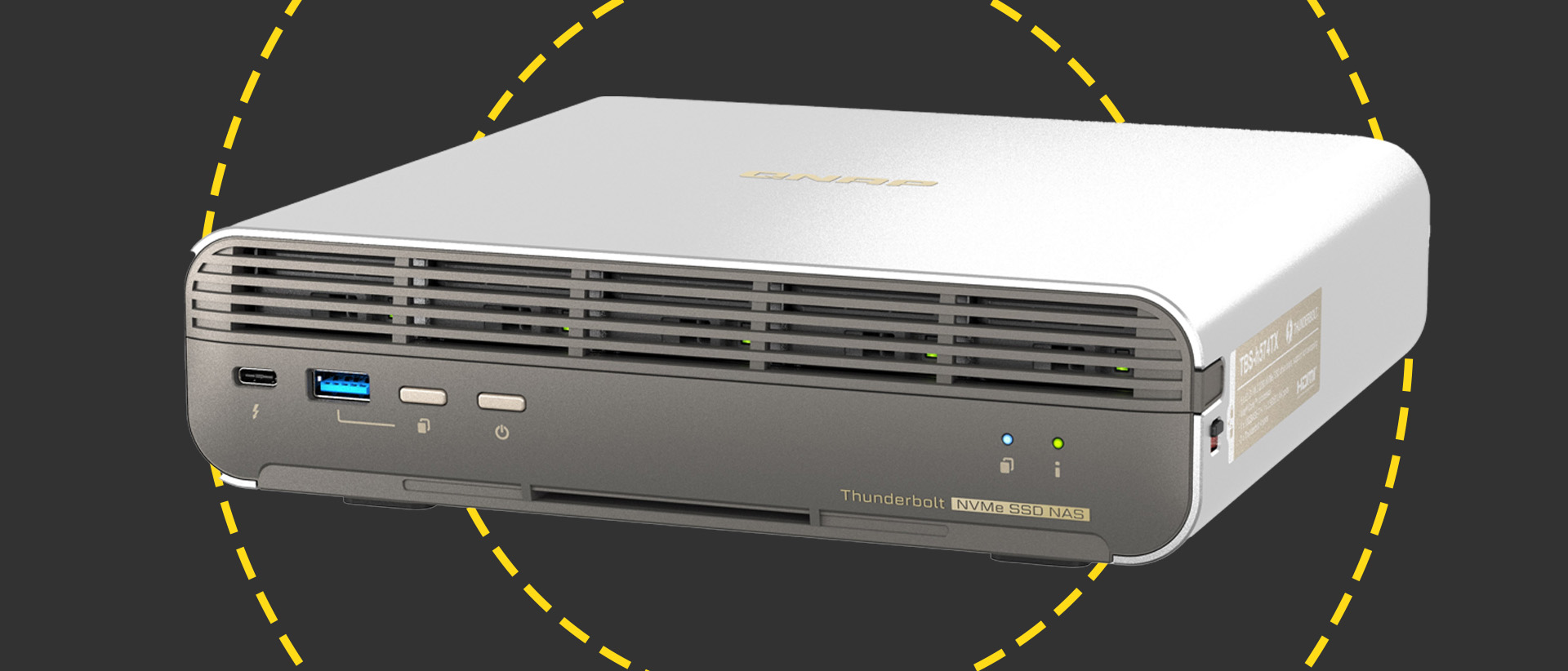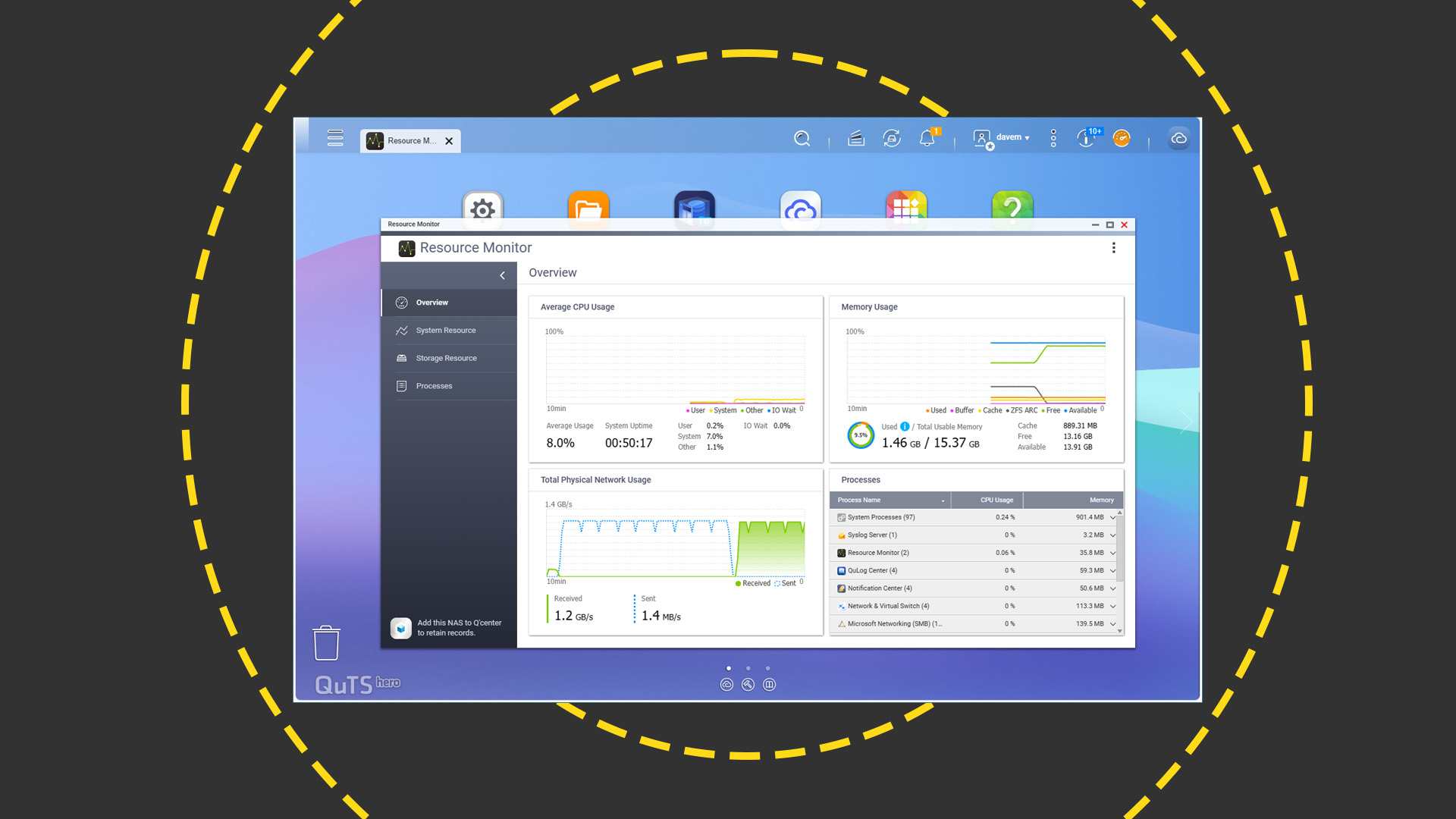Qnap TBS-h574TX review: A desktop NAS dynamo ideal for video editors
A well-designed desktop NAS with fast Thunderbolt 4 ports and an interesting SSD storage proposal

-
+
Smart design
-
+
EDSFF and M.2 SSD support
-
+
Dual Thunderbolt 4 ports
-
+
Fast Gen13 Core i5 CPU
-
+
Speedy performer
-
-
PCIe Gen3 SSD slots, non-upgradeable memory

Aimed firmly at content creators, media professionals, and small studios, Qnap's TBS-h574TX NASbook offers them a very particular set of skills. This diminutive desktop NAS appliance delivers an impressive hardware package with its pair of Thunderbolt 4 ports adding plenty of appeal to those engaged in 4K video production projects.
There are some surprises in the storage department as this all-Flash desktop NAS is the first we've seen to support EDSFF (Enterprise and Datacenter Standard Form Factor) E1.S drives. It offers five hot-plug bays across the front and Qnap has all the angles covered as the standard hot-plug carriers come with M.2 2280 adapters already fitted.
It's a powerful little box that's available with a choice of Intel's Gen13 Core i3 or Core i5 CPUs. We have the higher-end model on review which employs a 1.8GHz 12-core Core i5-1340PE CPU sporting four Performance cores with HyperThreading, eight Efficient cores, and an integrated Intel Iris Xe Graphics GPU.
Our appliance came with 16GB of non-upgradeable DDR4 memory while the Core i3 version gets 12GB. Bear in mind that Qnap's QuTS hero operating system (OS) is quite memory-hungry and if you opt for the cheaper version, you won't be able to use its integral data deduplication feature as this requires a minimum of 16GB.
Qnap TBS-h574TX review: Design and hardware
The TBS-h574TX looks good on the desktop as it's encased in a sleek and solid aluminum case with a posh gold Qnap logo on the upper surface. Weighing in at 2.24kgs unpopulated, it's easy enough to transport and the external power supply is pleasingly small as well.
The drive carriers are accessed from behind a magnetic front grill which has a small locking tab to one side. No tools are required to fit M.2 SSDs as you slot them in and let the retaining tab snap back to secure them but there's work to be done for EDSFF E1.S drives.
It depends on the type you choose as for 5.9mm high SSDs, you replace the M.2 adapter with the drive while the thicker 9.5mm and 15mm models dispense with the carrier and are screwed directly to the front locking assembly. Note that you won't see the full performance benefits of PCIe Gen4 NVMe SSDs as the appliance's slots are only the PCIe Gen3 x2 variety. Qnap recommends putting its heatsinks on them which are not included and we suggest you use them as during our performance tests, the two rear system fans ramped up and became quite intrusive.
You'll find Thunderbolt 4 ports fore and aft along with a choice of USB 3.2 and USB 2 ports. The rear panel offers an HDMI 1.4b port for piping 4K 30Hz video out from the GPU and network connections are plentiful as you have 2.5GbE and 10GbE RJ-45 with both the multi-Gigabit variety.

Qnap TBS-h574TX review: QuTS hero features
For testing, we fitted 480GB Kingston M.2 NVMe SSDs in the first two bays for use as a mirrored system pool and added two more 800GB M.2 NVMe SSDs for general data storage. Installation is a breeze as the web-based wizard disabled the default admin account, insisted we create a new one, and then proceeded to load the OS.
You can install Qnap's more nimble QTS software but QuTS hero offers a lot more features including stronger data protection features. ZFS copy-on-write delivers near unlimited NAS and iSCSI LUN snapshots along with inline data deduplication, compression, and end-to-end checksums that handle the self-healing of data corruption.
Although not so relevant in a five-bay appliance, RAID options are more extensive and you can opt for triple parity RAID to protect against three drive failures or triple mirroring which stores identical copies of data on three drives. And if you don't want your NAS data tampered with, QuTS hero offers a choice of two WORM (write once read many) policies that can be applied during share creation.
The Thunderbolt 4 ports support peer-to-peer connections up to 20Gbps with Mac and Windows hosts. Managed from the Network & Virtual Switch app, they also support directly connected external USB storage devices which automatically appear as network shares for authorized users.
Qnap TBS-h574TX review: 10GbE performance
As a NAS appliance, the TBS-h574TX has a very good turn of speed over 10GbE. With a share on the 800GB mirrored SSDs mapped over 10GbE to a Dell Windows Server 2022 host, we recorded top Iometer sequential read and write rates of 9.3Gbits/sec and 9.1Gbits/sec and swapping over to random operations returned precisely the same speeds.
These numbers highlight an important feature of the QuTS hero OS as its ARC (adaptive read cache) and ZIL (ZFS intent log) features are already very efficient making SSD caches unnecessary. Real-world speeds are just as good with a large 25GB test file copied between the NAS and server returning average read and write rates both of 9.1Gbits/sec.

If you want the appliance to present IP SANs, you won't be disappointed as a 250GB iSCSI target mapped to the server over 10GbE delivered sequential and random read and write rates identical to the NAS share. The Core i5 CPU has a lot of horsepower on tap as during all our tests, utilisation never exceeded 9% so there's clearly plenty of bandwidth available for Thunderbolt 4 activities.
Qnap TBS-h574TX review: Is it worth it?
The TBS-h574TX NASbook is in a league of its own as no other vendor offers integrated support for EDSFF E1.S and M.2 SSDs along with dual Thunderbolt 4 ports. More system memory would have been nice but that said, it packs an impressive hardware package into a compact and very well-designed desktop chassis. With the higher-end model on review costing a shade under £1,500 excluding VAT, it's an affordable choice for content creators who want high-speed direct access to large video files.
Qnap TBS-h574TX specifications
| Chassis | Desktop chassis |
| CPU | 1.8GHz 12-core Intel Core i5-1340PE |
| Memory | 16GB DDR4 non-upgradeable |
| Storage | 5 x EDSFF E1.S (max 15mm)/M.2 2280 NVMe SSD bays |
| RAID (QuTS) | RAID0, 1, 5, 6, 10, 50, 60, Triple Mirror, Triple Parity |
| Thunderbolt | 2 x Thunderbolt 4 |
| Expansion slots | None |
| Network | 1 x 2.5GbE, 1 x 10GbE RJ-45 multi-Gigabit |
| Other ports | 2 x USB 3.2, 1 x USB 2.0, HDMI 1.4b |
| Power | 120W external PSU |
| Management | Web browser |
| Warranty | 3 year limited |
Get the ITPro daily newsletter
Sign up today and you will receive a free copy of our Future Focus 2025 report - the leading guidance on AI, cybersecurity and other IT challenges as per 700+ senior executives
Dave is an IT consultant and freelance journalist specialising in hands-on reviews of computer networking products covering all market sectors from small businesses to enterprises. Founder of Binary Testing Ltd – the UK’s premier independent network testing laboratory - Dave has over 45 years of experience in the IT industry.
Dave has produced many thousands of in-depth business networking product reviews from his lab which have been reproduced globally. Writing for ITPro and its sister title, PC Pro, he covers all areas of business IT infrastructure, including servers, storage, network security, data protection, cloud, infrastructure and services.
-
 Cleo attack victim list grows as Hertz confirms customer data stolen – and security experts say it won't be the last
Cleo attack victim list grows as Hertz confirms customer data stolen – and security experts say it won't be the lastNews Hertz has confirmed it suffered a data breach as a result of the Cleo zero-day vulnerability in late 2024, with the car rental giant warning that customer data was stolen.
By Ross Kelly Published
-
 Women show more team spirit when it comes to cybersecurity, yet they're still missing out on opportunities
Women show more team spirit when it comes to cybersecurity, yet they're still missing out on opportunitiesNews While they're more likely to believe that responsibility should be shared, women are less likely to get the necessary training
By Emma Woollacott Published
-
 OpenAI wants developers using its new GPT-4.1 models – but how do they compare to Claude and Gemini on coding tasks?
OpenAI wants developers using its new GPT-4.1 models – but how do they compare to Claude and Gemini on coding tasks?News OpenAI says its GPT-4.1 model family offers sizable improvements for coding, but tests show competitors still outperform it in key areas.
By Ross Kelly Published